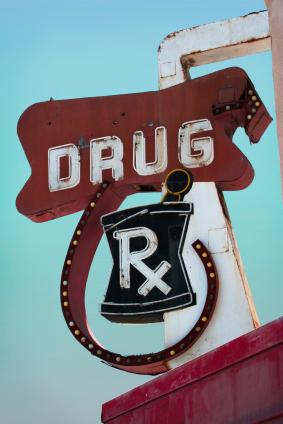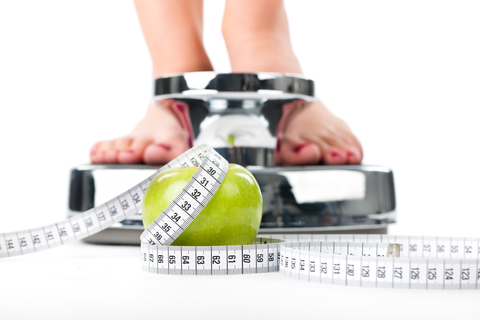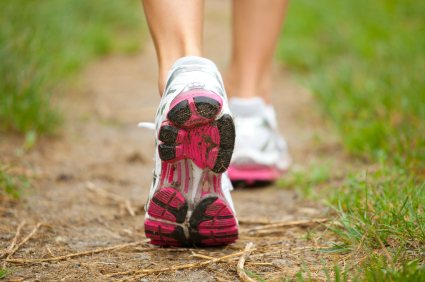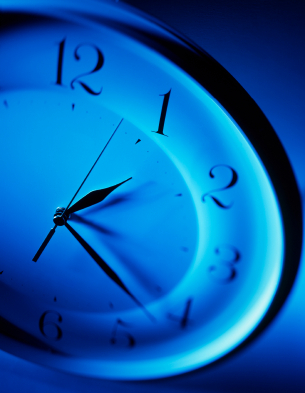Nonhormonal versus non-pharmaceutical
 HRT has suffered quite a hit in recent years and as a result, the Menopause Industrial Complex has been scrambling to find a viable replacement. And while I would like to believe in that altruism is driving the train, the cynic in me truly believes that it’s mostly profit motivated. That being said, I do admire the tenacity of industry to attempt to find a reasonable replacement for HRT (and hopefully a safer one) for women who want a fix for troublesome vasomotor symptoms — hot flashes and night sweats — and don’t want to make the effort or don’t understand how to navigate the landscape of alternative strategies.
HRT has suffered quite a hit in recent years and as a result, the Menopause Industrial Complex has been scrambling to find a viable replacement. And while I would like to believe in that altruism is driving the train, the cynic in me truly believes that it’s mostly profit motivated. That being said, I do admire the tenacity of industry to attempt to find a reasonable replacement for HRT (and hopefully a safer one) for women who want a fix for troublesome vasomotor symptoms — hot flashes and night sweats — and don’t want to make the effort or don’t understand how to navigate the landscape of alternative strategies.
However, let’s be clear: there is a distinction between nonhormonal treatments and non-pharmaceutical treatments, hence, when you start hearing about ‘nonhormonal’ options, be sure to ask what that means, because it’s likely that it means ‘not HRT,’ such as a new non-hormonal pharmaceutical alternative to HRT: LDMP, better known as low-dose paroxetine. For those of you who are unfamiliar with paroxetine, it is a type of SSRI used in the treatment of depression, panic disorder and social anxiety disorder; the popular antidepressant Paxil is a form of paroxetine.
Paroxetine is not the first antidepressant to be studied in menopausal women and you may recall that I wrote about the use of Lexapro for hot flashes about a year and a half ago. You can find that post here. However, paroxetine is the antidepressant that’s all the buzz right now, since Noven Pharmaceuticals presented two studies last week at the North American Menopause Society annual meeting. Note that it’s been reframed as ‘low-dose non-hormonal therapy for menopausal vasomotor symptoms,’ but ya still gotta call a spade a spade and what it is is an antidepressant.
Here’s what you need to know:
In one of two studies, 568 women (40+ years of age) who experienced 7 to 8 moderate or severe hot flashes on a daily basis of 50 to 60 on a weekly basis took either 7.5 mg of LDMP or placebo daily over six months. By the end of the first month (and in contrast to the study’s start), women who were taking LDMP experienced 28.9 fewer hot flashes per week (compared to 19 fewer per week for women taking placebo pills). By the third month, this increased by roughly 10 fewer per week in both groups. The severity of the hot flashes also significantly decreased. Safety wise, women taking LDMP reported nausea and bronchitis.
In the complementary study, which lasted for three months, 606 women in the same demographic took the same dose of LDMP or placebo. Decreases in mean number of flashes per week were pretty much on par with the first study (33 compared to 23.5 for placebo) and similarly, a trend towards maintaining and growing benefits were observed. Severity of hot flashes also declined but by the study’s end, were not significantly different than placebo. This time, women who took LDMP most frequently reported dizziness and fatigue.
Dr. James Simon, one of the studies’ investigators and a professor of ob/gyn at GWU School of Medicine claims that symptoms of menopause often go untreated when women are unable or unwilling to take hormone therapy, which is not entirely true. Another investigator — Dr. Andrew Kaunitz from the University of Florida College of Medicine in Jacksonville notes that if LDMP is approved by the FDA, “it could be the first nonhormonal option available for women.” Again, this statement is not entirely true. LDMP has the potential to become the first nonhormonal treatment APPROVED by FDA for vasomotor symptoms in menopausal women. There are other options out there but on the most part, they are not embraced by Western practitioners. Take note: while many Western practitioners will argue until they are blue in the face that alternative strategies have no role, are no better than placebo, and do not have evidenced-based trial data to support their use, they are simply incorrect. An unequivocal statement about every alternative strategy available to wo-man is bad medicine at best and at worst? Sheer ignorance.
Back to LDMP…LDMP appears to effectively diminish hot flashes and sweats but it is not without side effects. And while the dosage is considerably lower than full-strength antidepressants, we don’t have enough information to know if it will ultimately mimic its higher dose partner; the most common side effects reported in these trials are the very same that have been reported with Paxil. Another common side effect of Paxil that has not been explored (at least not publicly) in these trials is the effects on libido and it is a well known fact that as many women go through menopause, they experience declines in sex drive, lubrication and the ability to reach orgasm.
I say that the verdict is still out. And that based on the way that communications about this agent are being framed, that it’s about the spin. I guess that time will tell.
Read More
Wednesday Bubble: That old black cohosh
That old black cohosh. Is it magic or not?
Investigators from the esteemed Cochrane Collaboration reviewed 16 studies enrolling 2,027 perimenopausal or postmenopausal women using oral black cohosh, a median 40 mg daily for at least 23 weeks. In no uncertain terms, the authors concluded that “there is currently insufficient evidence to support the use of black cohosh for menopausal symptoms. However, there is adequate justification for conducting further studies in this area,” and …”the effect of black cohosh on other important outcomes, such as health-related quality of life, sexuality, bone health, night sweats and cost effectiveness also warrants further investigation.”
The reasons for this conclusion were several-fold:
- There was a wide range of doses used in the studies examined, making comparisons difficult.
- Many studies reported data that could not be used for the purpose of the analysis.
- A number of different measures were used in the trials and few looked at the same outcome.
- A lack of complete reporting made it difficult to measure the effect of black cohosh on vaginal atrophy, health related quality of life, sexual dysfunction and bone health.
In other words, available data do not allow any definitive conclusions but they still think that the herb is worthy of further exploration.
Guess what? So do I!
The last time I wrote about black cohosh was in January. In that post, I pointed out that black cohosh formulations differ. Consequently, so do their effects. The good news? The compound is safe and as the Cochrane authors point out, any GI, muscle or tissue complaints are rare, mild and reversible.
Personally? I would say that the verdict is still out. In the words of that iconic song…that old black cohosh still got me in its spell. The same old flash that I feel inside. And when that elevator starts its ride, darling, down and down I go, round and round I go, like a leaf that’s caught the tide.I should stay away but what can I do. I feel the burn and I’m aflame, aflame with such a burning desire, that only black cohosh can put out the fire.
For me, only black cohosh can put out the fire. What about you?
Read MoreDiet and fat and flashes! Oh my!
 A lot of you have written to me back channel to see if there is any evidence that diet affects menopausal symptoms. Up until now, I have run across many articles but little evidence on the topic. Hence, I was heartened to read about the positive effect of dietary changes and weight loss on hot flashes and night sweats in the online edition of Menopause.
A lot of you have written to me back channel to see if there is any evidence that diet affects menopausal symptoms. Up until now, I have run across many articles but little evidence on the topic. Hence, I was heartened to read about the positive effect of dietary changes and weight loss on hot flashes and night sweats in the online edition of Menopause.
The original intent of this study of over 17,000 women was to assess how a low-fat diet might benefit heart disease, breast and colorectal cancer and fracture risk among postmenopausal women. Nearly half of the women were asked to reduce their fat intake to only 20% of total energy and increase daily fruits and veggies intake to at least 5 servings daily, and whole grains, to 6 servings daily. Over the course of 5 years, they also received regular, intensive behavioral training conducted by a nutritionists and registered dietitians. The other half of the women only received a copy of Dietary Guidelines for Americans and other health-related materials. All were between the ages of 50 and 79.
Although weight loss was not a study goal, per se, on average women who agreed to changes in their diet lost an average of 4 pounds in the first year. And these women were able to reduce night sweats and hot flashes. What’s more? Women who lost more than 10% of their overall weight were significantly likely to eliminate their symptoms entirely (note that only a small proportion of women — 1% — reported having severe night sweats or hot flashes and symptoms were mostly mild to moderate in intensity). But, the findings get even more granular. The researchers write that when they did an additional analysis that women who lost the most weight (22 lbs) had more than twice the odds of eliminating moderate or severe vasomotor symptoms compared with women who maintained their weight.
Although the reasons are unclear, weight loss may reduce the amount of adipose tissue -the tissue that stores fat — and by default, reduce its insulation-type, thereby boosting the body’s ability to attack excessive body heat. Regardless, there are many reasons to maintain weight as we age. If this is an additional benefit, I say bring on the fruits and vegs!
Read More
Wednesday Bubble: Flashes and sweats and your heart
Be still my heart? Not this week. At least not as far as hot flashes and night sweats go. In fact, study findings that will be presented this coming weekend at the Endocrine Society ‘s 94th Annual Meeting suggest that hot flashes and night sweats that many women experience early in their menopause are not related to an increased risk for heart disease.
So what’s the 4-11?
Researchers have previously questioned whether or not timing of symptoms play a role in a woman’s increased risk for heart disease during menopause. They’ve found that experiencing symptoms only around the time menopause begins may actually reduce the risk for heart disease, or the risk of stroke, heart attack or death (compared with women who experience symptoms later). (If you’d like more about heart disease, aging and menopause, an archive of posts can be found here). To learn more, they have now analyzed the presence of markers in the body that have been linked to heart disease risk (e.g. high blood pressure, cholesterol, blood sugar, insulin, and specific blood markers that might indicate inflammation), in almost 60,000 women who were in menopause and had participated in the Women’s Health Initiative Observation Study.
These women were separated into groups, depending on the presence and timing of vasomotor symptoms:
1) No symptoms
2) Symptoms at start of menopause but not at the start of the study
3) Symptoms both at the start of menopause and the start of the study
4) Symptoms at the start of the study but not at the start of menopause
Importantly, women who had symptoms early in their menopause but not late did not appear to have elevated markers that may indicate heart disease risk. In comparison to this group, women whose vasomotor symptoms occurred only late in menopause appeared to have increased risk, mainly due to higher blood pressure and higher white blood cell counts. Those whose symptoms started early and persisted appeared to have higher levels of glucose and insulin, which indicated an increase in the risk for diabetes.
The researchers, who harken from Northwestern University, note that it’s unclear why timing of symptoms may influence heart disease, although the lead investigator, Dr. Emily D. Szmuilowicz has speculated that symptoms that occur long after menopause begin may indicated some sort of blood vessel abnormality. And while she and her colleagues have not suggested a strategy to attenuate this risk, it is clear that due diligence is needed. If your symptoms persist well into your menopause, see your health practitioner and ask him or her to run some tests. More importantly, hindsight is 20-20; be sure to instill lasting heart healthy habits early and maintain them while you age.
Read More
Exercise and sleep. Sleep and exercise. Does it? Or doesn’t it?
Among the many repeated themes on Flashfree, exercise and sleep rank highly. After all, exercise and physical activity are musts for women as they age. And sleep? Well, that goes without saying. However, although study findings have been fairly consistent with regard to connecting regular or vigorous physical activity to a reduction in some menopausal symptoms, the verdict is still out on sleep.
Sleep. Let me tell you; I sure could use some help in that department!
So what’s the latest and greatest? Does it? Or doesn’t it? Well, a study reported last month in the early online edition of Maturitas journal suggests that it might. The researchers write that studies that have evaluated the effects of aerobic activity on sleep are few and far between, and the results, contradictory. Still, they examined what would happen if they took a group of 176 sedentary women between the ages of 43 and 63 and subjected them to aerobic exercise training for six months. The exercise that half the women were asked to do consisted of 50 minutes of walking (or nordic walking with sticks) for two sessions and other aerobic activity for two sessions per week. The degree of the exercise was moderate, corresponding to about 64% to 80% of their target heart rates. The other half of the group remained sedentary. But both were asked to report via mobile phones how much hot flashes disrupted their sleep, and how much they slept every day on a scale of 1 to 5 (5=good, 1=poor).
The findings were pretty favourable. Women who exercised for 6 months experienced a 2% improvement in sleep quality compared to the women who didn’t (whose sleep quality, incidentally, declined by a half percent). Moreover, the exercise group, who had reported having hot flashes disturbing their sleep changed their tune by six to 10 weeks after starting their four times weekly routines and reported significantly fewer episodes than their sedentary peers.
Some may question that methods used to collect information; for example, studies that rely on recall are often called into question for accuracy and mobile phone data collection is uncommon. Still, the study was longer that most and the researchers validated their findings by scientific methods. That aside, since many readers come here to read the bottom line, is that regular exercise may improve sleep. It definitely affects quality of life and has a positive emotional benefit. Whether or not a 2% improvement is enough is really subjective. For me? I am happy to sleep through the night these days!
Read MoreMove it to lose it
 I mean it! New research suggests that if you want to hit that fatigue, depression, flashes and mood swings in one fell swoop, you may not have to resort to HRT. And the solution may be relatively simple: move.
I mean it! New research suggests that if you want to hit that fatigue, depression, flashes and mood swings in one fell swoop, you may not have to resort to HRT. And the solution may be relatively simple: move.
I can’t stress the importance of physical activity as we age enough. From bone health to heart health to mental health, it is the one accessible, equal opportunity strategy, regardless of income or geography. Because even if you don’t have entry to the gym, you can walk, run, bike, step, or engage in other activities that don’t require a membership or a monthly fee.
In face, researchers are reporting that simply engaging in vigorous physical activity, i.e. 7 days of a combination of moderate intensity/intense activities that add up to 3000 MET minutes a week) can significantly decrease menopausal symptoms, in particular fatigue, depression, insomnia and hot flashes. (Activity level is scientifically measured by units known as METs, or metabolic equivalents; vigorous activity is equivalent to 8 METs and moderate activity to 4 METs).
In a study of over 300 women between the ages of 45 and 60, the most active had about 75% lower menopausal symptom scores. Yet, exercising only moderately(e.g. 3 or more days a week of vigorous activity for at least 20 minutes daily or 5 or more days of moderately intense activity for at least 30 minutes a day) can also reduce strong menopausal symptoms, just not to the extent that more intense activity does.
The reasons behind the benefits of physical activity are pretty simple: your endorphins play a role in vasomotor symptoms and low levels are associated with increased release of luteinizing hormone (a hormone produced by the pituitary gland that is involved in ovulation), leading to hot flashes, heart racing, sleepless ness, anxiety and muscle discomfort. By raising your endorphin levels, even in light of declining estrogen, you stand a better chance at placing a roadblock in front of this process. However, this is only part of the story; body composition, mood and how well your themoregulatory system is functioning are also important.
Still, the message is clear: Move it to lose it, “it” being those trouble menopausal symptoms.
Read More







